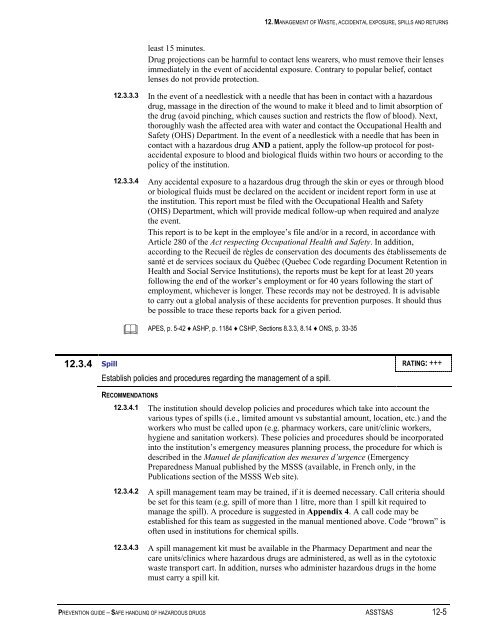Prevention Guide - Safe Handling of Hazardous Drugs - Irsst
Prevention Guide - Safe Handling of Hazardous Drugs - Irsst
Prevention Guide - Safe Handling of Hazardous Drugs - Irsst
You also want an ePaper? Increase the reach of your titles
YUMPU automatically turns print PDFs into web optimized ePapers that Google loves.
12. MANAGEMENT OF WASTE, ACCIDENTAL EXPOSURE, SPILLS AND RETURNS<br />
least 15 minutes.<br />
Drug projections can be harmful to contact lens wearers, who must remove their lenses<br />
immediately in the event <strong>of</strong> accidental exposure. Contrary to popular belief, contact<br />
lenses do not provide protection.<br />
12.3.3.3 In the event <strong>of</strong> a needlestick with a needle that has been in contact with a hazardous<br />
drug, massage in the direction <strong>of</strong> the wound to make it bleed and to limit absorption <strong>of</strong><br />
the drug (avoid pinching, which causes suction and restricts the flow <strong>of</strong> blood). Next,<br />
thoroughly wash the affected area with water and contact the Occupational Health and<br />
<strong>Safe</strong>ty (OHS) Department. In the event <strong>of</strong> a needlestick with a needle that has been in<br />
contact with a hazardous drug AND a patient, apply the follow-up protocol for postaccidental<br />
exposure to blood and biological fluids within two hours or according to the<br />
policy <strong>of</strong> the institution.<br />
12.3.3.4 Any accidental exposure to a hazardous drug through the skin or eyes or through blood<br />
or biological fluids must be declared on the accident or incident report form in use at<br />
the institution. This report must be filed with the Occupational Health and <strong>Safe</strong>ty<br />
(OHS) Department, which will provide medical follow-up when required and analyze<br />
the event.<br />
This report is to be kept in the employee’s file and/or in a record, in accordance with<br />
Article 280 <strong>of</strong> the Act respecting Occupational Health and <strong>Safe</strong>ty. In addition,<br />
according to the Recueil de règles de conservation des documents des établissements de<br />
santé et de services sociaux du Québec (Quebec Code regarding Document Retention in<br />
Health and Social Service Institutions), the reports must be kept for at least 20 years<br />
following the end <strong>of</strong> the worker’s employment or for 40 years following the start <strong>of</strong><br />
employment, whichever is longer. These records may not be destroyed. It is advisable<br />
to carry out a global analysis <strong>of</strong> these accidents for prevention purposes. It should thus<br />
be possible to trace these reports back for a given period.<br />
<br />
APES, p. 5-42 ♦ ASHP, p. 1184 ♦ CSHP, Sections 8.3.3, 8.14 ♦ ONS, p. 33-35<br />
12.3.4 Spill RATING: +++<br />
Establish policies and procedures regarding the management <strong>of</strong> a spill.<br />
RECOMMENDATIONS<br />
12.3.4.1 The institution should develop policies and procedures which take into account the<br />
various types <strong>of</strong> spills (i.e., limited amount vs substantial amount, location, etc.) and the<br />
workers who must be called upon (e.g. pharmacy workers, care unit/clinic workers,<br />
hygiene and sanitation workers). These policies and procedures should be incorporated<br />
into the institution’s emergency measures planning process, the procedure for which is<br />
described in the Manuel de planification des mesures d’urgence (Emergency<br />
Preparedness Manual published by the MSSS (available, in French only, in the<br />
Publications section <strong>of</strong> the MSSS Web site).<br />
12.3.4.2 A spill management team may be trained, if it is deemed necessary. Call criteria should<br />
be set for this team (e.g. spill <strong>of</strong> more than 1 litre, more than 1 spill kit required to<br />
manage the spill). A procedure is suggested in Appendix 4. A call code may be<br />
established for this team as suggested in the manual mentioned above. Code “brown” is<br />
<strong>of</strong>ten used in institutions for chemical spills.<br />
12.3.4.3 A spill management kit must be available in the Pharmacy Department and near the<br />
care units/clinics where hazardous drugs are administered, as well as in the cytotoxic<br />
waste transport cart. In addition, nurses who administer hazardous drugs in the home<br />
must carry a spill kit.<br />
PREVENTION GUIDE – SAFE HANDLING OF HAZARDOUS DRUGS ASSTSAS 12-5

















